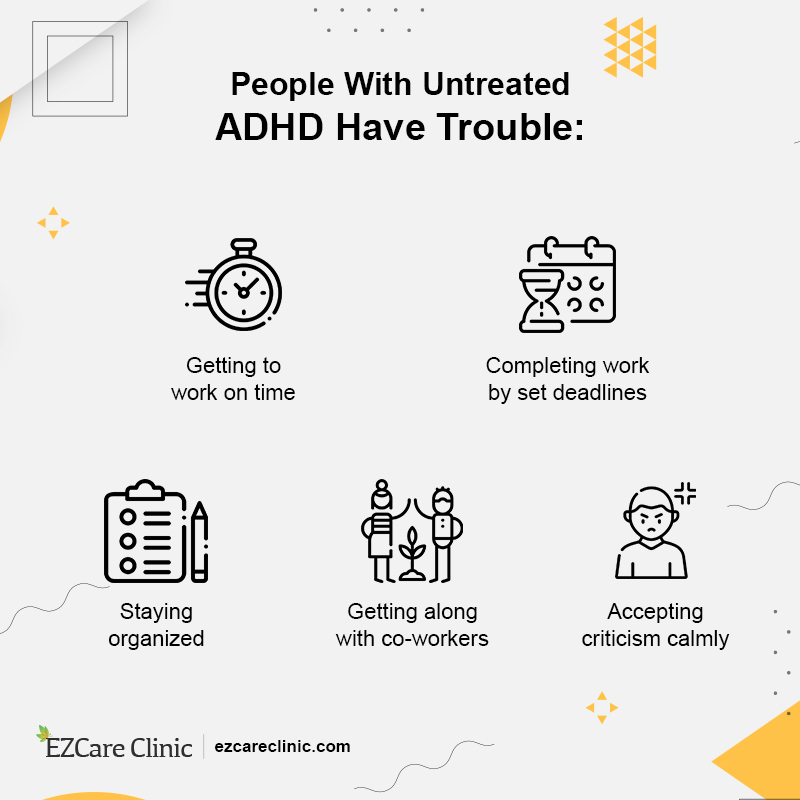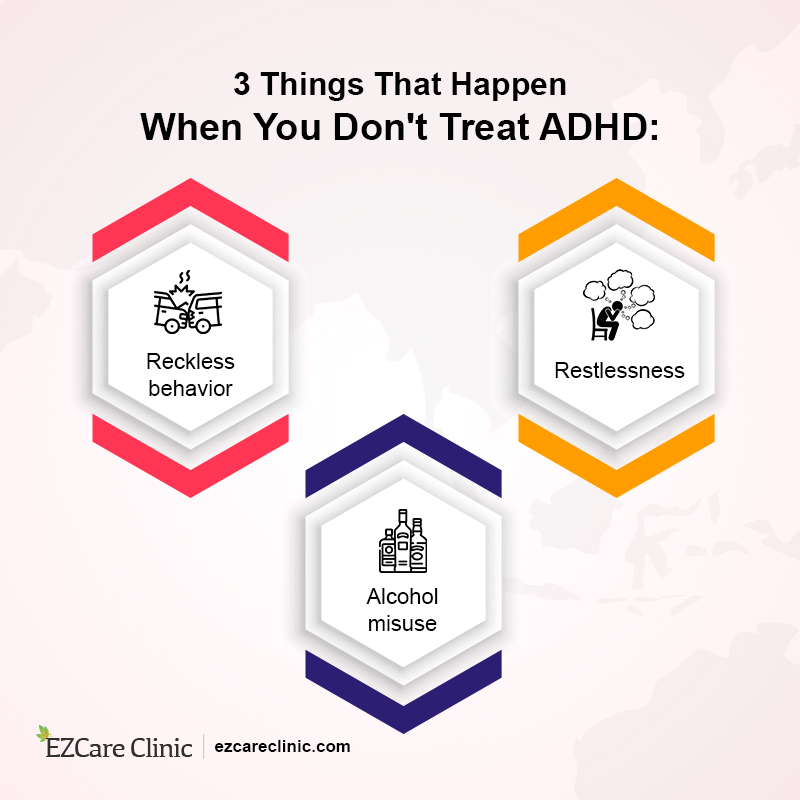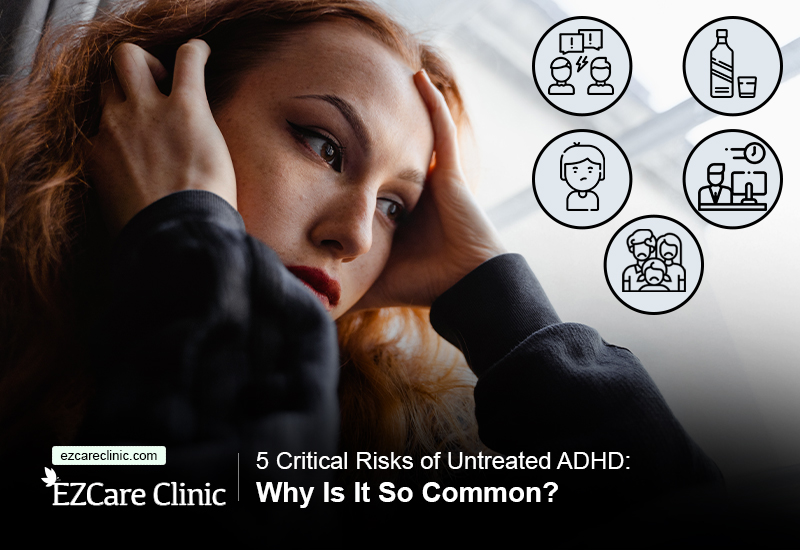Although numerous children get diagnosed with ADHD early, others progress into adulthood unaware that they suffer from the disorder. In a 2017 study conducted on 423 individuals, experts analyzed at least 20% of them with
Get your ADHD symptoms diagnosed and treated- Click the button below.
On average, a significant percentage of affected victims outgrow the condition without realizing that they had a problem in the first place. Furthermore, if family members or teachers barely understand the dynamics behind ADHD, it becomes almost impossible to detect it on time.
Why Is Untreated ADHD Common?
While ADHD affects both adults and children, it is often diagnosed before an individual turns 18. In extremely mild cases, medics find it hard to detect the disorder because symptoms are similar to normal behavior. Mainly, teachers or caregivers notice ADHD symptoms first because they spend more time with a child and can compare their behavior and learning capabilities with others.
On the other hand, identifying ADHD in adulthood is quite a task because the condition shares similar symptoms with:
- Mood disorders
- Depression
- Anxiety
Compared to male patients, women tend to display varied and confusing symptoms. Likewise, women develop enhanced coping mechanisms that help them hide signs leading to misdiagnosis and wrong treatment.
At the moment, there is no proven laboratory test that helps to diagnose ADHD. Therefore, experts make proper diagnoses through behavioral, developmental, and medical analysis. Keep in mind that the main objective is to discern ADHD symptoms with other medical issues and environmental influence that affects a person’s behavior.
Risks of Untreated ADHD
Altogether, there are severe risks of ADHD as adults compared to handling it in the early days.

What Does Untreated ADHD Feel Like?
Below are common risks related to untreated ADHD:
1. Complicated Personal Relationships
Basically, ADHD manifests itself through impulsivity, inattention, and hyperactivity. Given that a normal relationship requires these factors to thrive, most ADHD victims struggle to keep relations afloat.
Furthermore, specific impairment in everyday human functioning can be a solid basis for difficulty in relationships, emotional outbursts, and severe self-consciousness.
Due to the hypersensitive nature of a person living with ADHD, it is common for them to seek self-stimulation through provocations, miscommunications, or conflicts. In addition, the inattentiveness factor results in poor listening skills, forgetfulness, and lots of distractions.
In extreme untreated ADHD cases, patients display impulsivity through constant interruptions of conversations, impulse buying, and spontaneous decision-making. Beyond any doubt, these repetitive negative behaviors would lead to plenty of misunderstandings and rocky personal relationships.
Learn to get over the negative behavior caused by ADHD by booking a consultation with our mental health expert- Click below.
2. Enhanced Alcohol and Substance Use
Amongst various risks of untreated ADHD during childhood, substance use and dependence take a leading position in adulthood. In reality, experts indicate that about 15% of young adults and adolescents with ADHD develop substance use disorder (SUD) at a particular time in their lives.
SUD refers to drug and alcohol misuse resulting in impairment, addiction, and misunderstanding at home, work, or school problems. It is still not entirely clear why most ADHD patients end up struggling with SUD. However, according to experts SUD and ADHD have an interrelated relationship where some symptoms like depression and anxiety instigate the use of substances to feel more at ease.
3. Lack of Self Confidence
With minimal knowledge of ADHD characteristics and behaviors, most affected children receive multiple reprimands and punishments. Also, most victims struggle with learning difficulties due to poor concentration and fidgety. For this reason, ADHD patients develop low self-esteem and a feeling of unworthiness.
Above all, women suffer more with self-esteem risks of ADHD as teenagers compared to men. Some of the common symptoms you should look out for include extra sensitivity to criticism, hostility,

What Happens When You Don’t Treat ADHD?
4. Job Instability
Principally, untreated ADHD leads to poor performance in school. As a result, victims struggle to finish college or finding jobs in the future. Regrettably, others find it hard to focus on essential tasks in their working places.
Often this results in a continuous job instability cycle where victims hop from one company to another. Eventually, affected individuals are more likely to become
5. Poor Parent-Child Relations
Time and again, parents who have untreated ADHD struggle to control their impulses and emotions. Unfortunately, this prompts an inferior relationship with the children laden with constant conflict and frustrations.
Remember that the parental role requires one to identify erroneous behaviors in their children and seek expert help if need be. Nonetheless, ADHD can affect the decision capability of the parent leading to strained and negative parent-child interactions.
In the long run, parents may fail to seek proper assessment or delay getting the right treatment. Note that the motivation and ability to seek expert help depends on parental awareness, job stability, and state of mind.
Don’t let your ADHD go untreated- Click the button below to book your consultation.
The Crux of the Matter
Sadly, the risks of untreated ADHD during childhood steadily transgress to ugly repercussions that negatively affect the life of the victims and those around them. However, proper diagnosis and treatment go a long way in giving patients a lifelong solution.
Thankfully Ezcare Clinic has a whole load of verified professionals destined to give ADHD patients a new lease of life. Book an appointment now for effective conventional medication, behavioral coaching, proper nutrition, and lifestyle change.
Sources
- ADHD symptoms in non-treatment seeking young adults: relationship with other forms of impulsivity. (2017)
Source link - Other Concerns and Conditions with ADHD
Source link - A Longitudinal Study of Financial Difficulties and Mental Health in a National Sample of British Undergraduate Students. (2017)
Source link

